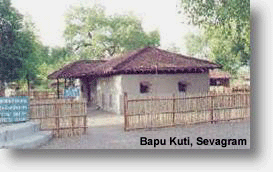|
Sevagram |
|
|
" Sevagram was the de facto capital of India " J.C. Kumarappa |
|
|
Sevagram, where Gandhiji has left an indelible impression of his immortal work to alleviate the suffering of the poor, is situated at a distance of 7 km from Wardha, the district head quarters and 80 km from Nagpur city. |
|
|
In the spring of 1936, Gandhiji settled in the remote village of Segaon rechristened as Sevagram identifying himself with poorest of the poor and dedicated his life to the cause of rural upliftment. At the Sevagram Ashram he intensified his efforts to realize his dream of Gram Swaraj (independence for the rural people). Many of his innovative programmes for rural upliftment such as the perpetuation of Khadi and other cottage industries, rural health care and education, saw the light of the day at this Ashram. |
|
|
It was here that crucial meetings of the Congress Working Committee were held and the great sons of soil Pandit Nehru, Sardar Patel, Abdul Kalam Azad, Rajendra Prasad amongst others took historic decisions that were to shape the destiny of India. The "Quit India" resolution was passed in July 1942 at Sevagram. Thus Sevagram had become the 'de facto capital of India' during the later part of our freedom struggle. Gandhiji left Sevagram Ashram in 1946 on a mission of peace and nonviolence to Noakhali & never to return. |
|
|
Today in addition to the Medical College, Sevagram has an Engineering college too. In and around Sevagram there are number of institutions such as the Gandhi Seva Sangh, Magan Sangrahalaya, Gandhi Memorial Leprosy Foundation, Manohardham and Paramdham ashram of Paonar, which perpetuate the message of the Mahatma's life. |
|
|
|
|
